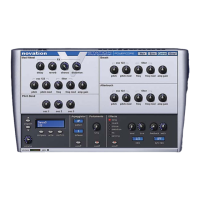FM Synthesis
FM synthesis
We have seen how we can create sounds by taking raw waveforms that are rich in harmonics,
combining them and processing these through filters and amplifiers under the control of
envelopes and LFOs, etc.. However, a form of synthesis was introduced in the ‘80s that used a
very different technique to create sounds and instead of taking complex waveforms and
breaking them down with filters, you start with simple waveforms and build more complex ones.
This technique was known as ‘FM synthesis’
FM Synthesis is the technique of using one waveform to Frequency Modulate - FM - another
to produce a more harmonically complex waveform. A ‘modulator’ is fed into a ‘carrier’ and as
the output of the modulator is increased, the waveform of the carrier becomes more and more
complex as harmonics are introduced.
The following diagram illustrates that the higher the modulation level between the modulating
wave and the carrier wave, the more the output waveform changes.
MODULATOR
MODULATION LEVEL
CARRIER
OUTPUT WAVEFORM
=0 =30 =90
In the illustration, the oscillators are producing sine waves. Many different sounds are possible
using this technique and they rely on the frequency and modulation level of the modulator into
the carrier.
However, as we have seen, the tone of an instrument rarely stays static during a note. It can be
deduced that if modulation level controls the output waveform, if we can control that level
somehow, we can cause tonal changes to occur.
22 Synthesis Tutorial

